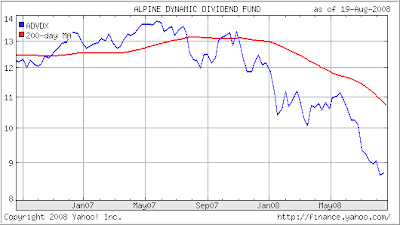 Reader Fred shared with me his approach to investing, which has worked well for him over the past 10 years. Here’s what he had to say:
Reader Fred shared with me his approach to investing, which has worked well for him over the past 10 years. Here’s what he had to say:
I subscribe to an advisory service called “The Chartist”. This service has had its subscribers 100% in cash since the middle of January 2008. So I am not invested in any mutual funds at the present time.
When I get a buy signal from the Chartist, I have followed a rule of investing only in no load mutual funds rated 5 stars by Morningstar. I only invest about 5 per Cent of my nest egg in any one mutual fund so I have about 20 mutual funds in my portfolio. I watch these funds closely using a computer program called Quicken. When any fund has a 10% loss, I sell it and invest in another fund rated five stars.
Why would you ever invest in a mutual fund which has a rating of less than five stars? Why not stay in the top 20% of funds as rated by a professional organization like Morningstar?
By using this simple system as described above, I have been able to double my nest egg after income taxes over the last ten years.
What do you think of my strategy?
Fred brings up some interesting points, and I am glad to hear that he has stuck with an approach that has worked for him for such a long time. I have found that most investors jump around way too much always in search of hoping to find the ultimate (and 100% correct) system. Of course, it does not exist.
Here are some comments I have about Fred’s approach:
First, I encourage any investment methodology that uses a discipline based on trend and momentum models along with clearly defined sell stops. The Chartist has done that for a long time and, while their approach differs from mine in some aspects, the core idea remains the same: Stay away from bear markets!
Second, if a 5% allocation works for you, that’s fine. I think that would be appropriate for stocks but is a bit of an over diversification for mutual funds.
Third, I personally don’t think much of the Morningstar ratings. I found them to be too much of a lagging indicator. From my experience, the result is that many rated funds are not necessarily in tune with current economic conditions at the time a Buy signal is generated.
Using momentum figures gives you a better picture as to which funds are showing superior performance at this time. After all, who cares what a fund has done 3, 5 or 10 years ago, I want to know how it is performing now.
Nevertheless, there is not just one method that is the correct one to use, because investing is not an exact science and every approach has its shortcomings and/or benefits. They key is to identify a method that aligns with your emotional make up and risk tolerance, and it appears that reader Fred has done just that.






